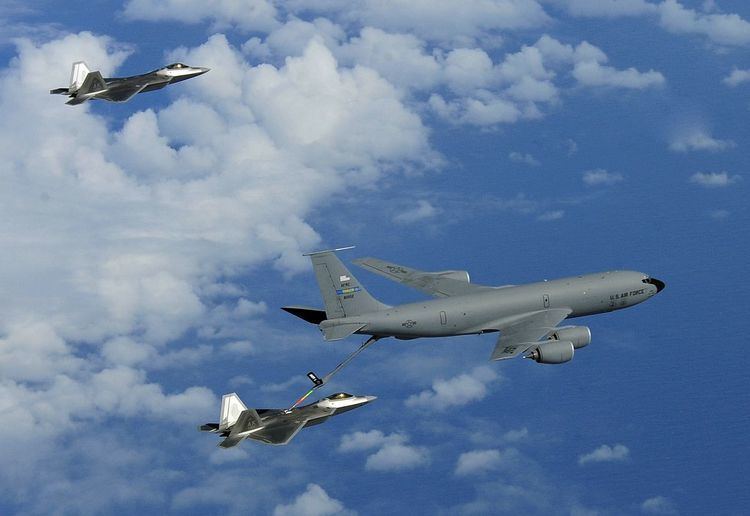Country United States Role Air Refueling | Type Wing Size 1100 Personnel | |
 | ||
Active 1944—1946; 1955–1961; 1961–1968; 1972–1973; 1975–present Branch | ||
The 507th Air Refueling Wing is a reserve component of the United States Air Force. It is assigned to Fourth Air Force of Air Force Reserve Command, stationed at Tinker Air Force Base, Oklahoma with elements at Altus Air Force Base and Will Rogers World Airport. If mobilized, the wing is gained by Air Mobility Command. It performs air refueling and airlift and employs approximately 1100 men and women. The wing also provides the full-time technicians and support personnel for all reserve units stationed at Tinker.
Contents
The first predecessor of the wing was the 507th Fighter Group, which was activated in 1944 and trained as a long range fighter unit for the Pacific Theater. Although the group was in combat for only two months, it earned a Distinguished Unit Citation three days before the Japanese surrender for destroying a number of enemy interceptor aircraft over Korea. In 1984, this group was consolidated with the 507th Fighter Wing into a single unit.
The group was redesignated the 507th Fighter Group (Air Defense) and activated in August 1955 at Kinross Air Force Base, Michigan, flying Northrop F-89D Scorpions and acted as the host for all active duty Air Force organizations at Kinross. It assumed an air defense mission with the F-89 and later, the Convair F-102 Delta Dagger, and finally the Convair F-106 Delta Dart. It was replaced by the 507th Fighter Wing in 1961 to provide support for the 4239th Strategic Wing (later replaced by the 449th Bombardment Wing) and the 37th Air Defense Missile Squadron. During the Cuban Missile Crisis, the wing dispersed one third of its interceptors to Phelps Collins Field, Michigan and placed all group aircraft on fifteen-minute alert status. Attrition of interceptors (and the fact that production lines closed in 1961) caused a reduction in the number of interceptor units and in September 1968 the 507th Wing was inactivated.
In May 1972 the group was activated in the reserves as the 507th Tactical Fighter Group, flying Republic F-105 Thunderchiefs, and replacing the 937th Military Airlift Group at Tinker. It was the first reserve group to participate in a Red Flag exercise or to deploy to Turkey for its annual tour of active duty. Upgrading to McDonnell F-4 Phantom IIs in 1980 and to General Dynamics F-16 Fighting Falcons in 1988, the group flew fighters until 1994. As the 507th Air Refueling Group, it began the worldwide air refueling mission with the Boeing KC-135R Stratotanker. From 1996 to 1997 it was assigned the 513th Air Control Group flying the Boeing E-3 Sentry AWACS aircraft and from 2008 to 2015 the 137th Air Refueling Wing of the Oklahoma Air National Guard was an associate unit of the wing. The wing participated in Operations Enduring Freedom and Iraqi Freedom and sent forces to assist with the recovery following Hurricane Katrina.
Overview
The 507th Air Refueling Wing supports Air Mobility Command airlift and air refueling requirements and United States Strategic Command’s emergency war order requirements. It regularly supports overseas deployments. The 507th employs approximately 1100 men and women. Approximately 200 members of the 507th are either civilian employees or Air Reserve Technicians who serve as a full-time support cadre, while the remainder are traditional reservists.
The wing also provides the full-time technicians and support personnel for the 513th Air Control Group and the 35th Combat Communications Squadron, reserve units stationed at Tinker, but assigned elsewhere.
Units and Missions
The 507th Air Refueling Wing consists of the following units and their components:
World War II
The wing was first activated as the 507th Fighter Group at Peterson Field, Colorado in October 1944 and was equipped with the long range version of the Republic P-47 Thunderbolt. Its original squadrons were the 463d, 464th and 465th Fighter Squadrons. One week later, it moved to Bruning Army Air Field, Nebraska without personnel or equipment to begin equipping and training.
In mid-December 1944, the 507th moved to Dalhart Army Air Field, Texas. There the group's personnel received training in preparation for assignment to the Pacific Theater of Operations. For four months they received combat training for long-range escort, strafing, and dive bombing. In late April the group departed Dalhart for shipment overseas, staging out of Fort Lawton, Washington.
The 507th arrived in the Pacific Theater in June 1945, and was stationed at Ie Shima in the Ryukyu Islands. The group was assigned to the 301st Fighter Wing. On 1 July 1945 it began flying airstrikes from Ie Shima, targeting enemy ships, railroad bridges, airfields, factories, and barracks in Japan, Korea, and China. The group encountered little enemy opposition on these strikes. On 8 August 1945 the group escorted Boeing B-29 Superfortress bombers on a raid on Yawata, Japan, flying its sole mission escorting bombers. For the first time it faced stiff opposition and shot down several Japanese fighters.
The group earned a Distinguished Unit Citation when it engaged and destroyed Japanese interceptor aircraft during a long-range fighter sweep to Korea on 13 August 1945. After the Japanese surrender, the 507th moved to Yontan Airfield, Okinawa in January 1946, and was inactivated there on 27 May 1946.
